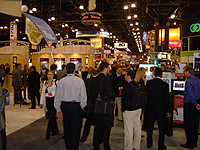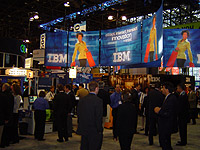- Categories:
Consumer Advocacy & Loyalty the Big Buzz at NRF's Big Show
  On the show floor at the National Retail Federation's 97th Annual Convention & Expo. |
At the National Retail Federation's 97th Annual Convention & Expo, held from January 13 - January 16 at New York City's Jacob K. Javits Convention Center, hot topics included consumer advocacy, customer satisfaction and loyalty, and the role technology will play in the store of the future (hint: it plays a big role). This week, in the first of a two-part report on the show, BTW looks at "Harness the Chaos in Today's Connected World," a session featuring author Daniel Pink (A Whole New Mind: Why Right-Brainers Will Rule the Future, Riverhead) and Fred Balboni of IBM Global Business Services.
Balboni's talk focused on how retailers can turn customers into advocates for their stores, and Pink spoke about how the world is moving from the information age to the conceptual age.
Balboni reported that IBM surveyed 20,000 customers about what they wanted in a shopping experience. "What are customers saying about you, the retailers," he said. "How many shoppers are advocates, ambivalent, or antagonists? What creates profitable growth? A new customer is starting to take shape." Customer-focused initiatives are becoming more important in retailers' quest to outpace their competitors, he noted.
 Fred Balboni |
Stores need to find ways to make the consumer an advocate, Balboni stressed. An advocate is loyal to a particular store and recommends it to others. "They will buy from you even if your competitor has the same product for the same amount or a little less."
Balboni outlined seven categories for driving customer advocacy, according to IBM survey participants:
- Creating a wonderful store experience
- Convenience ("the single biggest challenge for every retailer")
- A wide range of assortment and product;
- Quality
- Excellent customer service;
- Multichannel retailing (allowing a customer to check stock online before coming into the store, for example)
- On-shelf availability ("poor on-shelf availability creates antagonism")
"So where's price on this list?" Balboni said. "Numbers 1 through 7 ranked high in consumers' minds. A distinctive store experience will drive loyalty. But if a consumer isn't loyal to you, they become loyal to price. Now what works for one retailer doesn't necessarily work for another, but, overall, you need to commit to the customer."
 Daniel Pink |
Daniel Pink explained how the business and retail world is changing: our business and personal lives are morphing from a world dominated by left-brain traits (analytical and logical) to right-brain traits (big picture, artistic, and empathetic). "It used to be that what abilities mattered most were characteristic of the left side of the brain ... logical and linear. Now those traits are 100 percent necessary today, but they are not sufficient." He added: "I'm a left brain guy, but if you look at what's going on [in business today], I don't even think it's close that the scales are titling [toward right brain abilities]."
There are three reasons for the sea change:
- Abundance. The level of material well-being in the U.S. is "shocking," Pink said. "The middle class standard of living today would not be recognizable by my grandparents ... a car was a luxury item back then. But today there are more autos than there are licensed drivers." He pointed to the very successful self-storage business, a $22.6 billion a year business. "What problem is it trying to solve? Too much stuff."
The consequence of abundance, Pink said, results in things like designer toilet brushes. "If you want to sell more toilet brushes, you can a) make a dramatic leap in toilet brush technology; b) have a conceptual breakthrough; or c) remove the need for a toilet brush. So what do you do? You could compete on price, but that's a downward death spiral ... so you compete on aesthetics, the look and feel." With this kind of change, those who graduate from art and design colleges have a leg up on those without those right-brain skills.
- Asia. Simply put, left-brain tasks, such as programming, are more easily outsourced or off-shored to places such as India.
- Automation. "Machines replaced workers back in the last century," Pink noted. "Now, software is replacing left-brain workers." For example, law can be automated with software that helps people create their own wills or file for divorce.
Pink continued, "But there are six abilities that are hard to automate or outsource:
- Design. "You must be literate in design to be in business today.... Design is the de-comodifier."
- Story. The ability to tell a story about your product is where design was 10 to 15 years ago, Pink said, and "is about to break through the surface as a differentiator in consumer life." He pointed to Two Brothers Wine, which has a poignant story on the back of the bottle that grabs the consumer's attention. "Now if the wine wasn't any good, you wouldn't buy it any more, but it's fine."
- Symphony. This is being able to see the big picture. Here, Pink quoted Sid Caesar to illustrate the point: "The guy who invented the wheel was an idiot; the guy who invented the other three -- he was a genius."
- Empathy. You must have the ability to stand in someone else's shoes.
- Play. You should have a sense of humor.
- Meaning. You should pursue meaning and purpose in your work.
In February 2007, Daniel Pink was the plenary speaker at ABA's Second Annual Winter Institute. For a previous article on Pink, click here. --David Grogan

